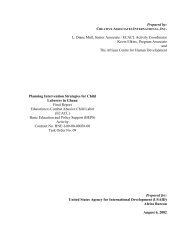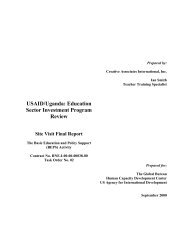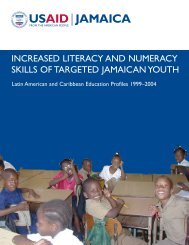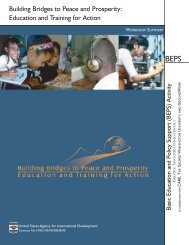Grandmothers: A Learning Institution - Basic Education and Policy ...
Grandmothers: A Learning Institution - Basic Education and Policy ...
Grandmothers: A Learning Institution - Basic Education and Policy ...
- No tags were found...
You also want an ePaper? Increase the reach of your titles
YUMPU automatically turns print PDFs into web optimized ePapers that Google loves.
in the family <strong>and</strong> social networks. Saguarogr<strong>and</strong>mothers are involved not only intreatment but also in health promotionwithin the family. McKee (1987) came tosimilar conclusions based on work in theHighl<strong>and</strong>s where “primary medical specialists”at the household level are seniorwomen who, in turn, train younger womento assume this role.Colombia: In urban Bogota, Myers <strong>and</strong>Indriso (1986) found that in extended familieschildcare was most frequently providedby female relatives, including mothers<strong>and</strong> mothers-in-law.Mexico: Related to infant feeding, a studyin rural Mexico documented the influenceof female social networks on childcarepractices of younger women. It was foundthat women with young babies more frequentlyconsult their mothers-in-law, mothers,<strong>and</strong> sisters for advice on infant feeding,than their doctors.EXAMPLES FROM THE PACIFICIn a 1998 study on breastfeeding practicesin urban Suva, in Fiji, it was found that, bothamong Indigenous Fijians <strong>and</strong> Indo Fijians,women’s infant feeding practices are significantlyinfluenced by the networks ofwomen within <strong>and</strong> around their families(UNICEF/Fiji 1998).EXAMPLES OF MORESYSTEMIC ANALYSES OF(GRANDMOTHERS’) ROLES INCHILDREN’S DEVELOPMENTMost of the literature discussed abovereports on discrete attitudes <strong>and</strong> practicesof gr<strong>and</strong>mothers’ practices related to program-specificchild development issues,such as childcare, breastfeeding or femalecircumcision. However, very few of themprovide information on gr<strong>and</strong>mothers’roles within household systems, <strong>and</strong> theirinfluence <strong>and</strong> involvement in decision-making.There are some examples of formativeassessments, carried out in the context ofchild development programs, that arebased on a family <strong>and</strong> community systemsapproach in which there is analysis both ofthe roles <strong>and</strong> influence of the varioushousehold actors on a child’s development,<strong>and</strong> of the specific practices of thosehousehold members. While no definitivemethodology exists for applying such anapproach, two other studies have beendescribed here that serve as examples ofhow this approach might be applied <strong>and</strong> ofthe type of results it could produce: first, astudy on newborn health conducted byHKI in Mali (Aubel et al. 2002), <strong>and</strong> second,a study on ECD carried out by SaveThe Children in Nepal (2000). The HKIstudy in Mali was a rapid assessment carriedout in one month with HKI <strong>and</strong>Ministry of Health staff. The Nepal studywas conducted over a one-year period bya team of researchers.SYSTEMS APPROACH TO STUDYINGNEWBORN HEALTH: MALIIn Mali, Helen Keller International (HKI), incollaboration with the Ministry of Health<strong>and</strong> Social Affairs, is implementing a communityproject to promote newbornhealth <strong>and</strong> reduce neonatal deaths. At theoutset of the project, a formative qualitativestudy was carried out in BambaraGRANDMOTHERS:THE LEARNING INSTITUTION67







